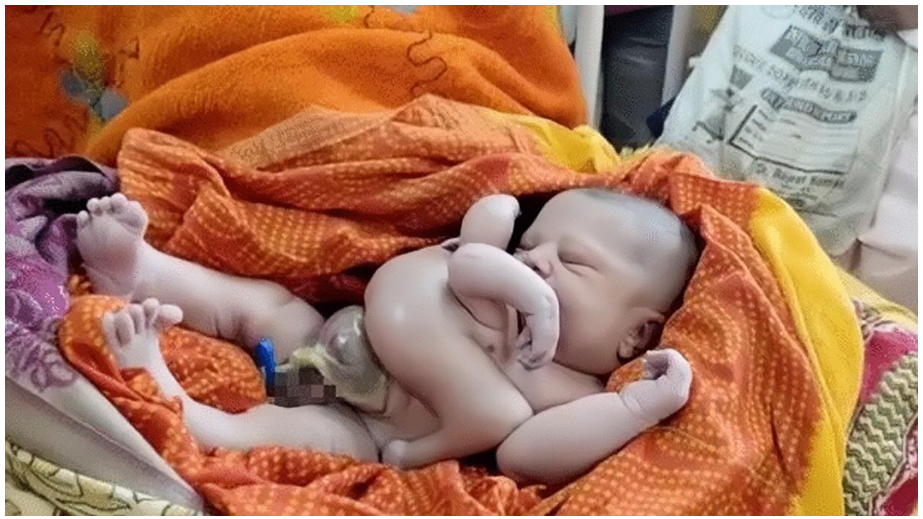In a rare and captivating case that has left medical experts astonished, a child was born with an extraordinary congenital abnormality known as polymelia. Polymelia refers to the presence of extra organs or limbs in newborns, a condition that affects only about 1 in every 1 million live births. This unique case has prompted doctors to delve into the mysteries of human anatomy and embryonic development, seeking answers to the fundamental question: Why do unusual births happen?
The child, whose identity remains confidential for privacy reasons, was born with 4 arms, 4 legs, and 2 hearts. Although these additional limbs possessed bones, muscles, and nerves, they lacked the essential bodily structures needed for complete functionality. Unfortunately, the baby could not survive.
Have You Ever Seen a Case Like This Before?
This remarkable anomaly has left medical professionals in awe, raising intriguing questions about the nature and management of such cases. For doctors, encountering an extraordinary case like polymelia is a once-in-a-lifetime experience. The presence of extra limbs presents unique challenges in terms of diagnosis and treatment. Medical professionals around the world are now asking themselves if they have ever witnessed a case of polymelia before and how they would manage a similar situation.
How Will Doctors Manage Such a Case?
Managing polymelia requires careful consideration of the severity of the condition and the functionality of the additional limbs. The medical team must assess the potential impact on the child’s overall health and well-being. Treatment options may include orthopedic surgery to address any structural abnormalities and ensure optimal functionality and quality of life for the child. While the challenges are significant, advancements in medical science and technology offer hope. Doctors are constantly pushing the boundaries of their knowledge and expertise to develop personalized management plans tailored to each unique case.
Why Do Unusual Births Happen?
Unraveling the mysteries behind unusual births like polymelia has long fascinated medical researchers. Genetic mutations and disruptions in embryonic development are often implicated in these congenital defects. By studying the origins of such abnormalities, scientists hope to gain a deeper understanding of the intricate processes involved in human development.
Can Polymelia Be Diagnosed?
Early detection and diagnosis of polymelia are crucial for effective management. Experts recommend prenatal screening during the sixth month of pregnancy to identify potential limb defects and associated birth abnormalities. Diagnostic strategies such as fetal ultrasonography and magnetic resonance imaging (MRI) have proven instrumental in detecting polymelia and other visible fetal abnormalities.
Fetal Ultrasonography: A Window into the Womb
Fetal ultrasonography is a widely utilized diagnostic tool that enables doctors to visualize and identify limb defects even before the baby is born. This early detection empowers medical teams to develop comprehensive treatment plans and provide appropriate support to both the infant and their parents.
MRI: Peering into the Fetal World
Magnetic Resonance Imaging (MRI) holds immense potential in detecting fetal limb abnormalities. While its clinical application in this context is still limited due to the complexities of fetal anatomy and pathology, ongoing advancements in medical imaging techniques promise to enhance diagnostic capabilities and deepen our understanding of conditions like polymelia.
As doctors and researchers continue to explore extraordinary cases like this one, they remain steadfast in their dedication to unraveling the mysteries of human development. Each unique birth anomaly offers an invaluable opportunity to expand medical knowledge, improve diagnostic capabilities, and provide the best possible care to these remarkable individuals. The case of the child born with polymelia serves as a powerful reminder of the resilience and potential of the human body, inspiring medical professionals to further their quest for understanding and innovation.
Dear doctors, have you ever seen a case like this before?
References
- Verma S, Khanna M, Tripathi VN, Yadav NC. Occurrence of polymelia in a female child. J Clin Imaging Sci. 2013 Apr 30;3:18.
- Bihar Baby Girl Born With 4 Arms, 4 Legs, And 2 Heart; Know Why Birth Defects Happen. [Cited: 16 June 2023].Available at: https://www.timesnownews.com/health/bihar-baby-girl-born-with-4-arms-4-legs-and-2-heart-know-why-birth-defects-happen-article-100993563#:~:text=In%20an%20unusual%20incident%2C%20a,%2C%20however%2C%20did%20not%20survive




